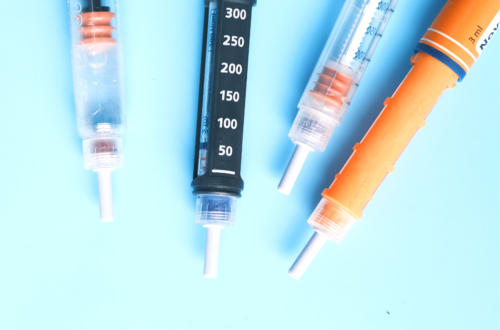
GLP-1 Therapy Part 4: Navigating the Decision to Discontinue
I recently had the pleasure of speaking at the Colorado Academy of Nutrition and Dietetics Annual Conference on the topic of nutrition strategies for effective GLP-1 use in obesity treatment.
This premier event, dedicated to supporting nutrition and dietetics professionals in Colorado, offered a valuable opportunity to share updated evidence on GLP-1 therapies, while also debunking common myths to promote informed and unbiased nutrition counseling.
In this four-part series, I’m excited to share my key recommendations to help support your practice. In Part 4, we’ll discuss some of the key questions to consider when deciding whether to discontinue therapy.
New to this series? Start with Part 1: Setting Realistic Weight Loss Expectations, Part 2: Preventing and Managing Side Effects, and Part 3: Strategies for Successful Weight loss.
Transitioning to Weight Maintenance
When transitioning from active weight loss to weight maintenance while using GLP-1 therapy, it’s important to apply structured medical nutrition therapy principles alongside thoughtful medication planning. Key considerations include:
- Maintenance Calorie Intake: Adjust to maintenance needs by recalculating energy requirements (Basal Metabolic Rate [BMR] × Activity Factor [AF]).
- Maintenance Protein Intake: Aim for 0.8–1.2 grams of protein per kilogram of body weight per day to preserve lean mass and support satiety.
- Dietary Guidelines for Americans (DGA): Align macronutrient and micronutrient intake with DGA recommendations for balanced, sustainable nutrition.
- Preconception Counseling: Provide guidance on nutrition, weight management, and medication safety for those planning pregnancy.
- Ongoing Social and Medical Support: Emphasize continued support systems, including regular medical follow-up, mental health resources, and peer support to reinforce lifestyle habits.
Successful transitions require personalized planning, patient education, and collaborative decision-making between the patient and their healthcare team.
Considerations for Discontinuation
Consider these four key areas of health when discussing whether to begin the discontinuation process of GLP-1 incretin-based therapy.
Evaluating Weight Loss Progress
✅ Assess whether an individual has achieved their weight loss goals, consider multiple indicators beyond just body weight (or BMI).
Body composition is important—evaluating fat mass, body fat percentage, and the fat-to-muscle ratio offers a more complete picture of progress. Additionally, improvements in body features such as shape, size, mobility, and physical performance can signal meaningful changes that align with the individual’s goals.
Assessing Metabolic Health
✅ Evaluate improvements in metabolic health. Consider this markers:
- A1c below 5.7%, fasting glucose under 100 mg/dL, and a HOMA-IR score less than 1.5, indicating improved insulin sensitivity.
- Optimal blood pressure, defined as below 120/80 mmHg.
- Cholesterol targets include total cholesterol under 200 mg/dL, LDL below 100 mg/dL, and triglycerides under 150 mg/dL.
Additionally, assessing changes in fat distribution—particularly reductions in visceral fat compared to subcutaneous fat—is important. Improvements in or resolution of metabolic-associated steatotic liver disease (commonly known as fatty liver) are also key indicators of better metabolic health.
Evaluating Cardiovascular Risk
✅ Assess individual cardiovascular risk. Consider a standardize tool or clinical marker.
Clinical trial data, such as the SELECT trial, demonstrated that semaglutide 2.4 mg reduced major adverse cardiovascular events (MACE) by 20%, highlighting the potential role of GLP-1 therapy in risk reduction.
Risk prediction tools like the ASCVD Score or Framingham Risk Score can help estimate an individual’s 10-year cardiovascular risk. Additional assessments, such as coronary artery calcification scoring and polygenic risk analysis, can further refine risk stratification and guide personalized prevention strategies.
Assessing Sustainable Lifestyle Change
✅ Evaluating whether an individual has established impactful lifestyle changes. Assess both knowledge and behavior.
This includes having a strong foundation in healthy eating principles, like understanding balanced meals, portion sizes, and nutrient quality, as well as implementing tools and strategies to support a healthier relationship with food. This may involve addressing emotional eating, building mindful eating habits, and developing sustainable routines.
Obesity as a Chronic Disease
Above all, it’s important to remember that obesity is classified as a chronic disease. Much like other noncommunicable chronic conditions—like diabetes, hypertension, dyslipidemia, and clinical depression—there is no cure. Instead, we have strategies for long-term management and reduction of complications.
Some individuals may be able to achieve sustained remission of obesity through lifestyle and environment changes alone, while others may require ongoing pharmacological treatment.
A recent systematic review and meta-analysis (the highest level of clinical evidence) suggests that most individuals using GLP-1 therapy for obesity will require long-term, possibly lifelong, treatment to maintain weight loss.
Key Takeaways
Deciding whether to discontinue GLP-1 therapy should be a thoughtful, individualized process grounded in clinical evidence and collaborative care. Use the following four key health domains to guide your assessment: weight loss progress, metabolic health, cardiovascular risk, and lifestyle sustainability.
While some individuals may achieve sustained remission through lifestyle changes alone, many will require ongoing pharmacologic support. Evidence consistently shows that discontinuing GLP-1 therapy often results in weight regain—underscoring the importance of long-term, personalized treatment planning.
- Rubino D, Abrahamsson N, Davies M, et al. Effect of continued weekly subcutaneous semaglutide vs placebo on weight loss maintenance in adults with overweight or obesity. JAMA. 2021;325(14):1-12. doi:10.1001/jama.2021.3224
- U.S. Department of Agriculture and U.S. Department of Health and Human Services. Dietary Guidelines for Americans, 2020-2025. 9th Edition. December 2020. Available at DietaryGuidelines.gov
- Spreckley M, Seidell J, Halberstadt J. Perspectives into the experience of successful, substantial long-term weight-loss maintenance: a systematic review. Int J Qual Stud Health Well-being. 2021;16(1):1862481. doi:10.1080/17482631.2020.1862481
- Almandoz JP, Wadden TA, Tewksbury C, et al. Nutritional considerations with antiobesity medications. Obesity. 2024;32(9):1613-1631. doi:10.1002/oby.24067
- Deanfield J, Verma S, Scirica BM, et al. Semaglutide and cardiovascular outcomes in patients with obesity and prevalent heart failure: a prespecified analysis of the SELECT trial. The Lancet. 2024;404(10454):773-786. doi:10.1016/S0140-6736(24)01498-3
- Deanfield J, Verma S, Scirica BM, et al. Semaglutide and cardiovascular outcomes in patients with obesity and prevalent heart failure: a prespecified analysis of the SELECT trial. The Lancet. 2024;404(10454):773-786. doi:10.1016/S0140-6736(24)01498-3
- Berg S, Stickle H, Rose SJ, Nemec EC. Discontinuing glucagon-like peptide-1 receptor agonists and body habitus: A systematic review and meta-analysis. Obes Rev. 2024;[published online ahead of print April 2024]:e13929. doi:10.1111/obr.13929

You May Also Like

Your Guide to Diabetes Supplies: Insulin Pens
July 4, 2023
Nutrition Strategies for Managing Postprandial Glucose
July 6, 2022
